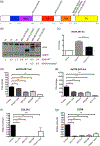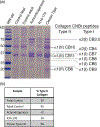Dominant-negative SOX9 mutations in campomelic dysplasia
- PMID: 31389106
- PMCID: PMC7608528
- DOI: 10.1002/humu.23888
Dominant-negative SOX9 mutations in campomelic dysplasia
Abstract
Campomelic dysplasia (CD) is an autosomal dominant, perinatal lethal skeletal dysplasia characterized by a small chest and short long bones with bowing of the lower extremities. CD is the result of heterozygosity for mutations in the gene encoding the chondrogenesis master regulator, SOX9. Loss-of-function mutations have been identified in most CD cases so it has been assumed that the disease results from haploinsufficiency for SOX9. Here, we identified distal truncating SOX9 mutations in four unrelated CD cases. The mutations all leave the dimerization and DNA-binding domains intact and cultured chondrocytes from three of the four cases synthesized truncated SOX9. Relative to CD resulting from haploinsufficiency, there was decreased transactivation activity toward a major transcriptional target, COL2A1, consistent with the mutations exerting a dominant-negative effect. For one of the cases, the phenotypic consequence was a very severe form of CD, with a pronounced effect on vertebral and limb development. The data identify a novel molecular mechanism of disease in CD in which the truncated protein leads to a distinct and more significant effect on SOX9 function.
Keywords: SOX9; bent bone dysplasia; campomelic dysplasia; dominant negative.
© 2019 Wiley Periodicals, Inc.
Figures




Similar articles
-
Hypomorphic and dominant-negative impact of truncated SOX9 dysregulates Hedgehog-Wnt signaling, causing campomelia.Proc Natl Acad Sci U S A. 2023 Jan 3;120(1):e2208623119. doi: 10.1073/pnas.2208623119. Epub 2022 Dec 30. Proc Natl Acad Sci U S A. 2023. PMID: 36584300 Free PMC article.
-
Regulation of human chondrocyte function through direct inhibition of cartilage master regulator SOX9 by microRNA-145 (miRNA-145).J Biol Chem. 2012 Jan 6;287(2):916-24. doi: 10.1074/jbc.M111.302430. Epub 2011 Nov 18. J Biol Chem. 2012. PMID: 22102413 Free PMC article. Clinical Trial.
-
Phenotype of five cases of prenatally diagnosed campomelic dysplasia harboring novel mutations of the SOX9 gene.Ultrasound Obstet Gynecol. 2010 Sep;36(3):315-23. doi: 10.1002/uog.7761. Ultrasound Obstet Gynecol. 2010. PMID: 20812307
-
Patient reports: Two novel frameshift mutations in the SOX9 gene in two patients with campomelic dysplasia who showed long-term survival.J Pediatr Endocrinol Metab. 2010 Nov;23(11):1189-93. doi: 10.1515/jpem.2010.187. J Pediatr Endocrinol Metab. 2010. PMID: 21284335 Review.
-
SOX9 and the many facets of its regulation in the chondrocyte lineage.Connect Tissue Res. 2017 Jan;58(1):2-14. doi: 10.1080/03008207.2016.1183667. Epub 2016 Apr 29. Connect Tissue Res. 2017. PMID: 27128146 Free PMC article. Review.
Cited by
-
Signaling Pathways in Bone Development and Their Related Skeletal Dysplasia.Int J Mol Sci. 2021 Apr 21;22(9):4321. doi: 10.3390/ijms22094321. Int J Mol Sci. 2021. PMID: 33919228 Free PMC article. Review.
-
Case report: Cystic hygroma accompanied with campomelic dysplasia in the first trimester caused by haploinsufficiency with SOX9 deletion.Front Genet. 2022 Aug 29;13:950271. doi: 10.3389/fgene.2022.950271. eCollection 2022. Front Genet. 2022. PMID: 36105084 Free PMC article.
-
Novel SRY-box transcription factor 9 variant in campomelic dysplasia and the location of missense and nonsense variants along the protein domains: A case report.Front Pediatr. 2022 Nov 18;10:975947. doi: 10.3389/fped.2022.975947. eCollection 2022. Front Pediatr. 2022. PMID: 36467484 Free PMC article.
-
Case report: A de novo Non-sense SOX9 mutation (p.Q417*) located in transactivation domain is Responsible for Campomelic Dysplasia.Front Pediatr. 2023 Jan 18;10:1089194. doi: 10.3389/fped.2022.1089194. eCollection 2022. Front Pediatr. 2023. PMID: 36741086 Free PMC article.
-
Hypomorphic and dominant-negative impact of truncated SOX9 dysregulates Hedgehog-Wnt signaling, causing campomelia.Proc Natl Acad Sci U S A. 2023 Jan 3;120(1):e2208623119. doi: 10.1073/pnas.2208623119. Epub 2022 Dec 30. Proc Natl Acad Sci U S A. 2023. PMID: 36584300 Free PMC article.
References
-
- Bell DM, Leung KKH, Wheatley SC, Ng LJ, Zhou S, Wing Ling K, … Cheah KSE (1997). SOX9 directly regulates the type‐ll collagen gene. Nature Genetics, 16, 174–178. - PubMed
-
- Bogaert R, Tiller GE, Weis MA, Gruber HE, Rimoin DL, Cohn DH, & Eyre DR (1992). An amino acid substitution (Gly853‐‐>Glu) in the collagen alpha 1(II) chain produces hypochondrogenesis. Journal of Biological Chemistry, 267, 22522–22526. - PubMed
-
- Foster JW, Dominguez‐Steglich MA, Guioli S, Kwok C, Weller PA, Stevanović M, … Schafer AJ (1994). Campomelic dysplasia and autosomal sex reversal caused by mutations in an SRY‐related gene. Nature, 372, 525–530. - PubMed
Publication types
MeSH terms
Substances
Grants and funding
LinkOut - more resources
Full Text Sources
Research Materials

